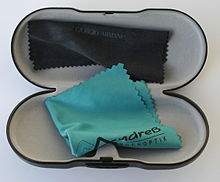
Back Van der Waals se krag Afrikaans قوى فان دير فالس Arabic Van-der-Vaals qüvvələri Azerbaijani Сілы Ван-дэр-Ваальса Byelorussian Сили на Ван дер Ваалс Bulgarian ভ্যানডার ওয়ালস বন্ধন Bengali/Bangla Van der Waalsove sile BS Forces de van der Waals Catalan بەندی ڤان دەر ڤۆلس CKB Van der Waalsovy síly Czech


In molecular physics and chemistry, the van der Waals force is a distance-dependent interaction between atoms or molecules. Unlike ionic or covalent bonds, these attractions do not result from a chemical electronic bond;[2] they are comparatively weak and therefore more susceptible to disturbance. The van der Waals force quickly vanishes at longer distances between interacting molecules.
Named after Dutch physicist Johannes Diderik van der Waals, the van der Waals force plays a fundamental role in fields as diverse as supramolecular chemistry, structural biology, polymer science, nanotechnology, surface science, and condensed matter physics. It also underlies many properties of organic compounds and molecular solids, including their solubility in polar and non-polar media.
If no other force is present, the distance between atoms at which the force becomes repulsive rather than attractive as the atoms approach one another is called the van der Waals contact distance; this phenomenon results from the mutual repulsion between the atoms' electron clouds.[3]
The van der Waals forces[4] are usually described as a combination of the London dispersion forces between "instantaneously induced dipoles",[5] Debye forces between permanent dipoles and induced dipoles, and the Keesom force between permanent molecular dipoles whose rotational orientations are dynamically averaged over time.
- ^ Woodford, Chris (2 July 2008). "How do microfiber cloths work? | The science of cleaning". Explain that Stuff. Retrieved 11 February 2022.
- ^ IUPAC, Compendium of Chemical Terminology, 2nd ed. (the "Gold Book") (1997). Online corrected version: (2006–) "van der Waals forces". doi:10.1351/goldbook.V06597
- ^ Garrett, Reginald H.; Grisham, Charles M. (2016). Biochemistry (6th ed.). University of Virginia. pp. 12–13.
- ^ Tschumper, Gregory S. (20 October 2008). "Reliable Electronic Structure Computations for Weak Noncovalent Interactions in Clusters". In Lipkowitz, Kenny B.; Cundari, Thomas R. (eds.). Reviews in Computational Chemistry. Vol. 26. John Wiley & Sons. pp. 39–90. doi:10.1002/9780470399545.ch2. ISBN 9780470399545.
- ^ Mahan, Gerald D. (2009). Quantum mechanics in a nutshell. Princeton: Princeton University Press. ISBN 978-0-691-13713-1. OCLC 226037727.
© MMXXIII Rich X Search. We shall prevail. All rights reserved. Rich X Search